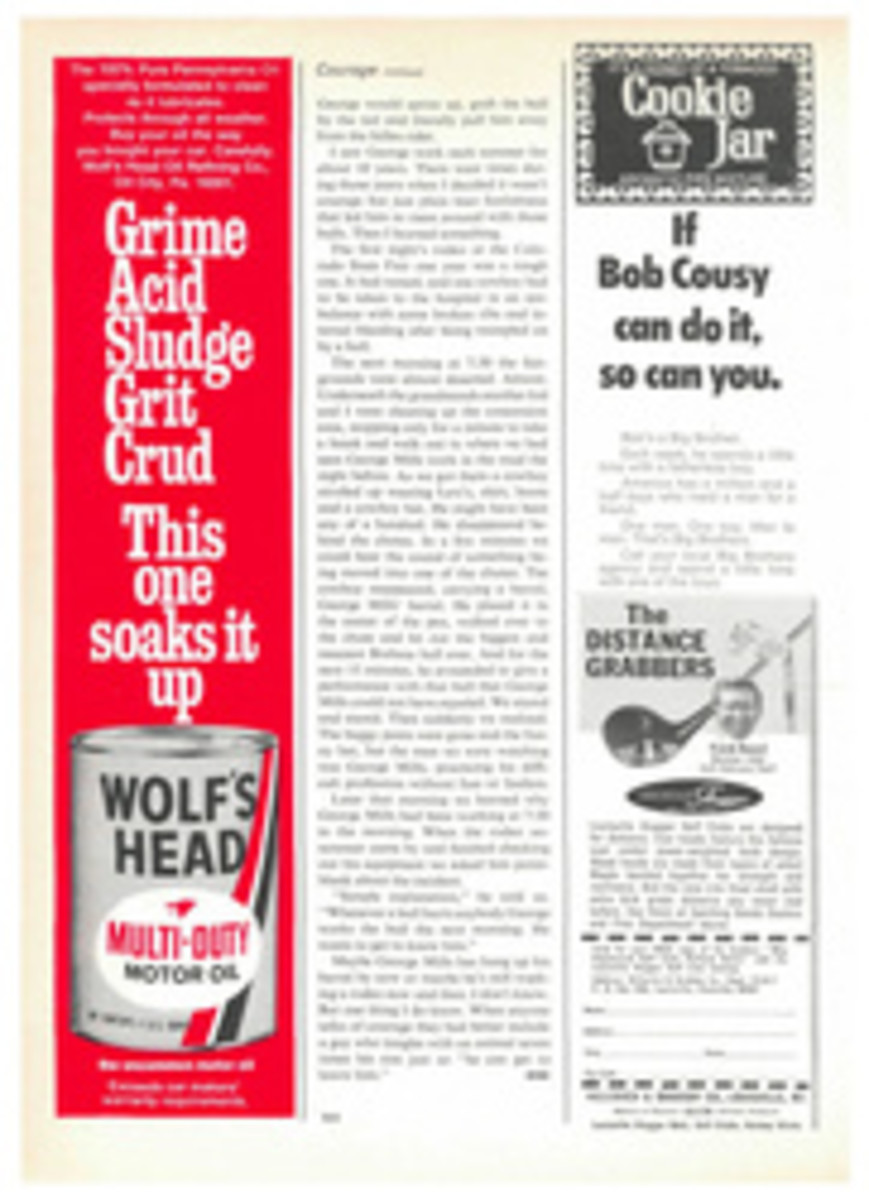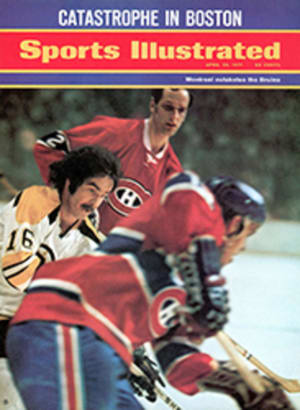
On the horns of a dilemma
Big-game hunting is suffering from success. Or at least it is suffering from an overburden of awards and trophies that are the rewards of success. While the most prized of hunting trophies are those horned and hairy heads hung on walls, hunting these days also has a mixed bag of medals, plaques, cups, bowls and statuettes. About $55 million is spent each year in the U.S. on sports trophies of all kinds, and hunting takes a fair share of the business.
But there are complications about big-game hunting awards that are never encountered in, say, winning an Olympic gold medal in the 100-meter dash. A shortage of witnesses, for example. No crowd of cheering spectators, no television cameras are on hand when someone sets a world record by shooting some animal with a larger set of horns than anybody ever shot before. More often than not, only two people—the hunter and his guide—know the circumstances under which a big-game record was set. Later the taxidermist, the official measurer and maybe one or two other people get into the act. But no one knows how many trophies have been taken by illegal chases, trophy switches, guide-hunter substitutions, altered measurements or falsified affidavits. The checks are few, the temptations great and the desire for an eight-point entry in Boone and Crockett's Records of North American Big Game or in Rowland Ward's records of African and Asian game is such that otherwise-honest men have succumbed to fraud.
The pressures of this sort of trophy competition are enormous. One sensational example reached the public recently when Gary Swanson, a California taxidermist-guide, was arrested for the illegal hunting of desert bighorn sheep and it was charged that 32 hunters (all of whom were indicted by the Federal Government) had paid Swanson up to $3,000 a head to hunt these legally protected animals under his guidance. Most of Swanson's clients were respected members of their communities. Normally they would no more consider cheating in sport than they would in their business and professional lives. One explanation may be found in the conflicting requirements that govern hunting awards and trophies.
On one hand, some awards have no meaning at all. Grace Kelly once won an airline's award without ever firing a gun. Winchester selects its Outsdoorsman of the Year by a poll of outdoor writers (4,000 such writers, according to one press release; 1,200, according to another). To Winchester's credit, it expects some experience from its outdoorsmen. The late film star Robert Taylor, who won the first Winchester award in 1954, even hunted occasionally, and so did Walter Alston—for rabbits—although it did not hurt that the Dodgers won the pennant the year he was Winchester's Outdoorsman. (Considerably more sophisticated now, Winchester gives trophies to the winners of two genuinely distinguished awards, those of the international hunting club, Shikar-Safari, and Game Conservation International.)
Air France, which does most of its big-game stalking on Madison Avenue, sporadically bestows its hunting award, a bronze-and-wood plaque, on some recipient chosen by obscure methods, "to tie in with one of our commercial tours or promotions," as an Air France spokesman explained with Gallic candor. It does not follow that because an award is commercially sponsored it must be commercially compromised. To expect sponsors to foot the bills and then decline credit is unrealistic, but it is not unrealistic to expect a sponsor to assume responsibility for the quality of its awards. In fact so many blatantly phony awards involve such improbable recipients that they are ignored by everyone except the promoters who dream them up and the people who receive them.
But if the sham awards are too easy to be of importance, those with real distinction are so difficult as to be almost impossible. It is in the pursuit of these that trophy hunters are tempted to take shortcuts, to buy hides and horns, or claim a head shot by a guide, or pay $3,000 for a desert bighorn sheep.
These top awards represent genuine, even extraordinary, achievements. Shikar-Safari Club International, for example, gives an award for the best Asian and African animal taken by a member—and its membership includes some of the world's best hunters. An awards committee determines the relative merit of each entry and the circumstances surrounding its actual taking. A record head is not sufficient to win the award. The hunter must have earned his trophy the hard way. In years when none of the entries meets the organization's high standards, the awards are withheld.
More important still is the Weatherby Big Game Trophy, the ultimate award for hunters. The trophy itself is nothing you would want to carry with you on a hunt. It stands 3½ feet high, weighs 46 pounds, takes four months to cast and assemble and costs approximately $1,000. It costs a great deal more to win one, though expenditures have nothing to do with such an achievement. C.J. McElroy, a Los Angeles contractor who won the Weatherby two years ago, estimated that he spent five months afield annually for a dozen years and that his trophy cost him more than half a million dollars.
When Roy Weatherby conceived the award in 1956 his goal was not to honor the hunter who set a particular record but to reward the sportsman who made the greatest lifetime achievement in hunting. "Many hunters spend year after year passing up average heads to look for record trophies," Weatherby says, "but we all know that most of the world records are not taken this way but by accident or luck. I wanted to do something to recognize the hunter who does not necessarily hold all the records but who has spent his life hunting and collecting the broadest number of species, the most difficult to hunt and the hardest to find, from the widest range of areas. Such a person must also have made significant contributions to conservation, and he must be a sportsman beyond reproach."
The first award was presented to Herb Klein of Dallas, the dean of all big-game hunters in the world today. Since then only 32 people have qualified as nominees. They have been outstanding, even extraordinary, representatives of the sport, yet 10 withdrew their names from competition because they could not match the accomplishments of other nominees. Except for Herb Klein, no winner received the award the first year his name appeared on the ballot. Several were on the ballot five years or more before winning. The award committee consists of 10 men, including Weatherby and four previous winners—Klein, Warren Page, Jack O'Connor and Prince Abdorreza Pahlavi of Iran. Their job is to sift the qualifications of every nominee, ranking them not only on the formal affidavits that list species taken, places hunted, records held and conservation contributions, but on information gathered from guides, other hunters and business and social contacts. The balloting is secret, and not even Weatherby knows how the other judges voted until the final scores are tallied and he is advised of the winner by registered mail.
Last year's winner, George Landreth, a 43-year-old petroleum engineer, was more relieved than anything else. "I thought, now I can relax again," Landreth says. "It is hard to imagine how much pressure the Weatherby trophy puts on its nominees. At first I did not think that winning it mattered that much, but as time passed and I realized that I had a good chance at it, I began to feel the springs tightening."
Landreth knew there were certain animals one must have to win: all the species of North American big game, and the grand slam of sheep—Dall sheep, found in Alaska; Stone sheep, which range through British Columbia; the Rocky Mountain bighorn; the desert bighorn. In fact, Landreth had four such grand slams. "You know you should have all the major species of Asian and African game," Landreth says, "and then a lot of unusual and rare ones, such as bongo and mountain nyala. Then there are the truly exotic species of Asian sheep—the Ovis poli of the Pamirs, and the Ovis ammon of Mongolia."
Landreth was the sixth person to take an Ovis poli and the first in 40 years to take an Ovis ammon. "As it turned out, I had all the hard ones, but I did not have a tiger," Landreth says. "Roy told me I had a good chance if I had a tiger, but without one he did not see how I could be expected to win. I started that day making calls to book a tiger hunt, squared away my business as best I could and took off. All I wanted was to get the tiger. Suddenly I realized I was not hunting for sport anymore. I was filling a quota, achieving an end. What happens is that you start trying too hard, and you find yourself doing things you would not ordinarily do. Sooner or later the pressure gets so bad you may take a shortcut, and then you spend the rest of your life regretting it."
Landreth did not take a shortcut to get his tiger, but shortcuts are what confuse the record books and lead to sensations like those of the Gary Swanson case. Trying to achieve the grand slam in sheep has been intoxicating to many hunters. All four North American species are demanding to hunt; the desert sheep, because of its limited numbers, also is heavily protected throughout its remaining range. All legal hunting is by permit. These are so few that in recent years only one in 100 prospective sheep hunters has managed to get one.
In Southern California, where there is a protected but relatively sizable population of desert sheep, the Government has charged that Gary Swanson rounded up clients willing to pay heavily to hunt these trophies. Last fall law-enforcement agents arrested Swanson and confiscated his records, alleging he had put 32 desert bighorns, illegal but impressive, in the trophy rooms of satisfied hunters and had also put some hefty deposits in his bank account. Swanson, whose trial is scheduled for next month, denies the charges. Some of the others under indictment have not yet been heard from. The episode illustrates how easily big-game records can be tarnished.
A guide in Angola recently reported taking a roan antelope that would clearly place high in the book. He wanted to sell it before the new trophy reached Rowland Ward's so the buyer's name could be entered in place of his own. He sent out six letters. Within a week he received four offers for the head. Taxidermists report receiving fresh hides accompanied by horns that are years older. Providing "pickup" horns, as they are called—to be substituted for less impressive ones actually taken—has become so profitable that some natives have switched from guiding to hunting pickups.
Only five hunters have taken all 26 species of American big game. This past fall Bill Bond, a Texan, accomplished it when he got a Shiras moose in Wyoming. "When a man is closing in on No. 26," he says, "the pressure on the guide to find the animal, and on the hunter to shoot straight and true, is something else!" And the need to keep the records straight is greater than ever. One flagrant violation of ethics casts an indelible shadow over all hunters.
ILLUSTRATION

